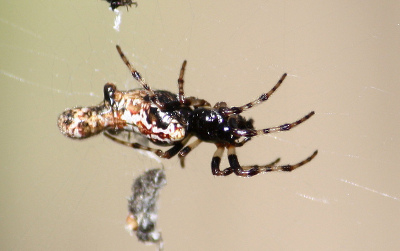Three-lobed Spider
Category: Arachnida Spider

Facts about Three-lobed Spider, There are several Three-lobed Spider species in the universe. The Cyclosa species is one of them and it is differentiated with a bright yellow-orange abdomen with several black and white markings. And just like the other species the Three-lobed Spider has a three-lobed abdomen. The Female Three-lobed Spider female is quite larger than its male counterpart.
Physical Description of Three-lobed Spider
The Cyclosa spiders have a cylindrical abdomen which is easily recognized by a characteristic U-shaped demarcation which is between the raised head and its flat thoracic region.
The Three-lobed Spider has a well armed last pair of legs and with strong spines. It is usually around 6 mm in length, and they have a conical hump placed at the front of the abdomen. The female can reach up to 9 mm and 5 mm for the males.
Behavior of Three-lobed Spider
Three-lobed Spiders enjoy decorating their vertical orb-webs with bands of rubbish that could be an insect that was bound in silk for later meals or it is a waste.
The Three-lobed Spider makes small circular orb web, and the center of their web has loops of coarse silk. The spider enjoys to time from the center of the web, and it can easily be mistaken for a dead flower or debris stuck on the web.
This is not an aggressive species and sometimes it is thought to be too small to cause any harm to humans.
Diet of Three-lobed Spider
The diet of Three-lobed Spider consists of mainly insects. The small insects get trapped on the web, and immediately it is engulfed with enough silk that it can not escape.
Three-lobed Spiders have oversize brains.
In the Three-lobed Spider the oxygen is bound to "hemocyanin" a copper-based protein that turns their blood blue, a molecule that contains copper rather than iron. Iron-based hemoglobin in red blood cells turns the blood red
Three-lobed Spiders have two body parts, the front part of the body is called the Cephalothorax-(the thorax and fused head of spiders). Also on this part of the body is the spider’s gland that makes the poison and the stomach, fangs, mouth, legs, eyes and brain. Three-lobed Spiders also have these tiny little leg-type things called (pedipalps) that are next to the fangs. They are used to hold food while the spider bites it. The next part of the Three-lobed Spiders body is the abdomen and the abdomens back end is where there is the spinnerets and where the silk producing glands are located.
Habitat of Three-lobed Spider
The Three-lobed Spider like living in low shrubs. A mature female’s web reaches lengths close to half a meter in width, and they make egg-sac outside their web. Though most spiders prefer resting on their webs with head facing downwards, Three-lobed Spider can rest on its web with unsystematic orientations.
Spiders belong to a group of animals called "arachnids", mites and Scorpions and a tick is also in the arachnid family. An Arachnids is a creature with eight legs, two body parts, no antennae or wings and are not able to chew on food. Spiders are not insects because insects have three main body parts and six legs and most insects have wings.
The Arachnids are even in a larger group of animals called "arthropods" an invertebrate animal of the large phylum Arthropoda, which also include spiders, crustaceans and insects. They are the largest group in the animal world, about 80% of all animals come from this group. There are over a million different species. There are more than 40,000 different types of spiders in the world.
The muscles in a Three-lobed Spiders legs pull them inward, but the spider can't extend its legs outward. It will pump a watery liquid into its legs that pushes them out. A Three-lobed Spider’s legs and body are covered with lots of hair and these hairs are water-repellent, which trap a thin layer of air around the body so the spiders body doesn't get wet. It allows them to float, this is how some Three-lobed Spiders can survive under water for hours. A Three-lobed Spider feels its prey with chemo sensitive hairs on its legs and than feels if the prey is edible. The leg hair picks up smells and vibrations from the air. There are at minimum, two small claws that are at the end of the legs. Each Three-lobed Spiders leg has six joints, giving the Three-lobed Spider 48 leg joints. The Three-lobed Spider’s body has oil on it, so the spider doesn't stick to it’s own web.
A Three-lobed Spiders stomach can only take liquids, so a spider needs to liquefy their food before they eat. They bite on their prey and empty its stomach liquids into the pray which turns it into a soup for them to drink.
A male Three-lobed Spider has two appendages called "pedipalps" a sensory organ, instead of a penis, which is filled with sperm and insert by the male into the female Three-lobed Spider’s reproductive opening.
Spiders do not have a skeletons. They have a hard outer shell called an exoskeleton-(a rigid external covering for the body in some invertebrate animals). The exoskeleton is hard, so it can’t grow with the spider. The young Three-lobed Spiders need to shed their exoskeleton. The Three-lobed Spider has to climb out of the old shell through the cephalothorax. Once out, they must spread themselves out before the new exoskeleton will harden. Now they have some room to grow. They stop growing once they fill this shell. Female Three-lobed Spiders are usually bigger than males.
Female Three-lobed Spiders lay eggs on a bed of silk, which she creates right after mating. Once the female Three-lobed Spider lays her eggs, she will than cover them with more silk.

 Back To Category Arachnida Spider
Back To Category Arachnida Spider